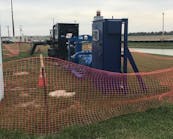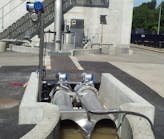Sensaphone
undefined
With 22,000 residents in 10,000 homes and more than 3 million gal of raw sewage treated every day, the Lake Stevens Sewer District (LSSD) in Washington state has reason to obsess about maintaining a smooth operation.
Built in 1956, the sewer system serves an area of nearly 6,700 acres (5,690 of which are outside the city’s limits) surrounding Lake Stevens, a 1000-acre lake about 40 miles north of Seattle. The district operates 8.9 miles of collection systems, 9.7 miles of interceptors (15-in. to 36-in sewer mains), 30 lift stations and a wastewater treatment plant.
While the system typically operates smoothly, there are times when unexpected events—power outages, pump failures and other mechanical breakdowns—cause partial or total system shutdown. To avoid those nightmares, LSSD uses a Sensaphone 2000 remote monitoring and alarm notification system.
Rick Lewellen, deputy manager for operations at LSSD, learned about the monitoring system during a tradeshow. At the time, LSSD monitored its facilities with two phone dialers: one at the treatment plant and one at a lift station that pumps waste from the basin to the treatment plant.
Lewellen convinced his superiors that the system would improve monitoring capabilities and provide more control and functionality in the process. They first specified it for two smaller projects, including the rehab of an existing lift station, which did not have a dialer installed at the time.
“We were so happy with the initial results that we added another Sensaphone in 2001 and again in 2002. Now we have eight units, and we specified the [system] for installation in three more lift stations under construction,” Lewellen said.
The system has eight channels, eight universal inputs that accept wet or dry contact sensors, 4-20mA signals, thermistor and pulse count devices. Its data-logging capabilities allow it to store, retrieve (locally and remotely) and then analyze 32,000 time-stamped records. No monthly service fees are required.
The LSSD is using the system to monitor the wet well level in some of its 30 lift stations. It also monitors pump failures, PLC (programmable logic controller) operations or failures, pump priming systems and more. The district has the unit programmed to dial an answering service when an alarm occurs. The service notifies the on-call staff member who decides how best to react to the alarm.
The key benefit of the system, Lewellen said, is the ability to trend the recorded data, enabling operators to spot problems before a malfunction occurs. “We can graph the trends of the instruments over the last 24 hours and see which one was malfunctioning and at what point. It saves the operator time and the district the expense of sending someone to investigate the site. We can analyze the maintenance and malfunction from the desktop before deciding how to correct it,” he said.
The system also enables the LSSD to schedule preventive maintenance. “This prevents major station breakdowns,” Lewellen said.



